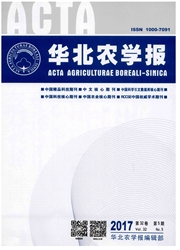

 中文摘要:
中文摘要:
TGA转录因子通过与NPR1基因协同作用参与植物对病害的防御作用。从水稻突变体HX-3基因组中分离到一个TGA转录因子rTGA4的5'非翻译区1 995 bp的序列(pTGA),该序列与日本晴基因组序列仅有94%的相似性。经PLACE和PlantCARE序列分析表明:该片段含有典型的TATA-box、CAAT-box等基本转录元件,以及脱落酸、乙烯、茉莉酸甲酯、赤霉素以及病原菌响应元件等。将得到的pTGA利用T/A克隆法连接到植物表达载体pCXGUS-T/A上,通过花序浸染法转化拟南芥,并对转基因拟南芥进行分子检测及GUS组织化学染色。结果表明,在苗期时GUS主要在幼苗根尖表达,在其他部位均没有表达;而在成熟期GUS在多处均有表达,特异性并不明显,表明该启动子是受生长发育阶段调控的组织特异性启动子。通过对rTGA4启动子的特征研究,为进一步克隆HX-3中的抗性基因以及利用奠定基础。
 英文摘要:
英文摘要:
The family of TGA transcription factors cooperates with NPR1 to play a very important role in disease defence.A 1 995 bp sequence of the 5′UTR of a new TGA transcription factor rTGA4 was isolated from rice mutant HX-3 genomic DNA and named pTGA,which shows 94% similarity to the genomic sequence of nipponbare.Sequence analysis of the promoter by PLACE and Plant CARE showed that the cloned fragment contained such some basic transcription element TATA and CAAT-Box,and some putative cis-elements,such as abscisic acid responseive,ethylene responsive,MeJA responsive,gibberellin-responsive and pathogen responsive elements.Then an expression vector was constructed by connecting the pTGA with pCXGUS-T/A and it was transformed to Arabidopsis thaliana by Agrobacterium-mediated method.The transgenic plants were analyzed by PCR amplification and GUS staining.We found that GUS gene was mainly expressed in shoot tip of seedling and did not detect GUS activity in other parts,but the specific expression was lost during mature period.So we consider that the pTGA is a tissue specific promoter which is regulated by growth stage.Characterization of the promoter of the rTGA4 lays a foundation for cloning the resistant gene in HX-3 and its further application.
 同期刊论文项目
同期刊论文项目
 同项目期刊论文
同项目期刊论文
 期刊信息
期刊信息
